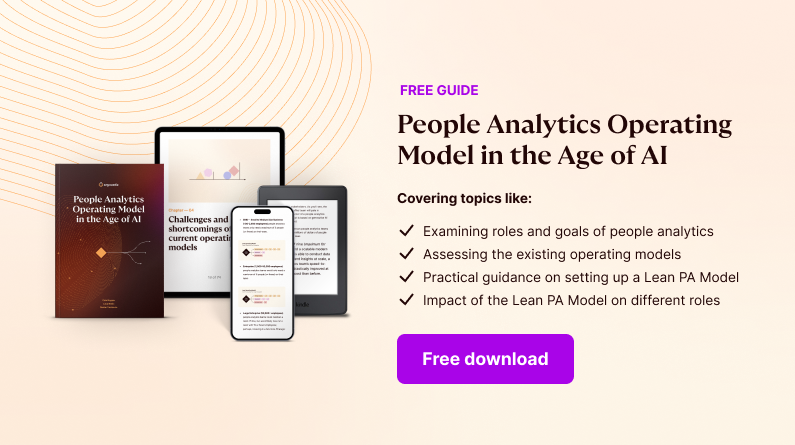We asked people analytics practitioners to help predict key trends that will emerge — or continue to shape — the field of people analytics. Here is what we found.
There is a vibe-shift going on with people analytics at the moment. If you look back at previous years’ prognostications, you could likely copy and paste what was written in 2018 to the upcoming year, with peripheral changes around the edges.
Not anymore, it seems.
2023 is likely to be a much different year for people analytics, and those who either can’t, or won’t, acknowledge it are likely to be left behind.
To get a good view of what’s to come, we asked people analytics practitioners from a variety of industries to help predict key trends that will emerge — or continue to shape — the field of people analytics. Read on for their take.

Why the big shift in people analytics?
People analytics emerged in prominence as a discipline between 2010 and 2020.
That ten year period is distinguished by one superordinate trend: almost all key economic indicators were trending in the right direction – typically “up and to the right”.
People analytics was the beneficiary of the positive economic trends of this time period.
Growth in people analytics teams? Check.
Growth in salaries? Check.
Growth in technology, budgets, and resources? Check.
This trend was only accelerated during pandemic times because data on workforces became center-stage, as organizations ran a societal-wide experiment with remote work that they didn’t sign up for.
The cost to borrow money was near zero; therefore unprecedented capital injections were made into the economy to make sure the pandemic didn’t become cataclysmic. Those investments also allowed the people analytics “gravy-train” to continue.
However, those times are coming to a close… Economic conditions – inflation, layoffs, unemployment, etc – will set the tone for 2023 plans in people analytics.
So, how does people analytics work when the economic indicators aren’t “up and to the right”?
It looks like a function not made of opulence, but made of necessity.
People analytics in 2023
People analytics in 2023 – barring some major positive economic shifts – has the following trends on the horizon:
Understanding productivity
Automating people analytics tasks
Flexbile-first – to be or not to be
Best HR tech emerges
Psychological recession and employee wellbeing
To higher engagement through in-person team trust-building
Tracking career pathing
Predicting mental health challenges
Building a financial case for non-core HR
Diversity efforts become even more data-driven
Our take on people analytics in 2023
Justifying existence of people analytics teams
Is your people analytics team a luxury or essential? If all your team is doing is manually managing data and reporting, it will likely be automated. Conversely, if your team is only working on years-long research “passion projects”, your work will also be disrupted. You need ways of proving your value…today. Your team must show a direct linkage to business strategy execution, and how it is contributing to the success of the business. Is what HR is doing working/paying for itself? Profit center > cost center.
Deployed analytics and the buy vs build dilemma
Why have a human do something manually a technology could do cheaper and more effectively? People analytics technology in the past was slow and cumbersome, but with the investment in HR technology since the pandemic, HR tech has improved dramatically. Patrick Coolin’s article on “Crossing the 2nd Wall of HR” discusses moving past “advanced analytics” and to “deployed analytics”. 2023 is the year of deployed analytics, but with resource constraints most organizations will need to “buy” rather than “build” that capability.
Scenario/workforce planning for cost modelling
There is workforce planning in times of growth, and workforce planning in times of change/shrinkage… Leaders need a better understanding of their revenue per employee, the efficiency of human capital, and cost of labor throughout the business. They need to understand who their critical talent is, and if they are being retained. You can help.
Business acumen
Does your people analytics team know how your business makes money? Could they explain it to the CEO in a way that they wouldn’t be embarrassed? Most people analytics team don’t have sufficient business acumen. Don’t be embarrassed, it’s common. 2023 is the year to change that. In an upcoming People Analytics World podcast, Cole Napper and Tracey Smith discuss effective ways for improving business acumen of people analytics teams.
Engagement/culture’s contribution to productivity
Does the expression “doing more with less” ring a bell? This will likely be the mantra of leaders in 2023. In this environment, listening to employees will be as important as ever to make efforts to improve culture, engagement, and productivity. Organizations who get this right will outcompete those who don’t.
Wild card:
OpenAI open-sourced its ChatGPT bot this week. ChatGPT’s answers about everything, including this article with Richard Rosenow about people analytics, are incredible. This may be the most disruptive technology released in a generation or more. We may be on the AI arms-race exponential, runaway intelligence trajectory that silicon valley luminaries have predicted.
Want to join the discussion? Sign up here →
Editor’s note: The responses have been lightly edited for clarity and brevity.